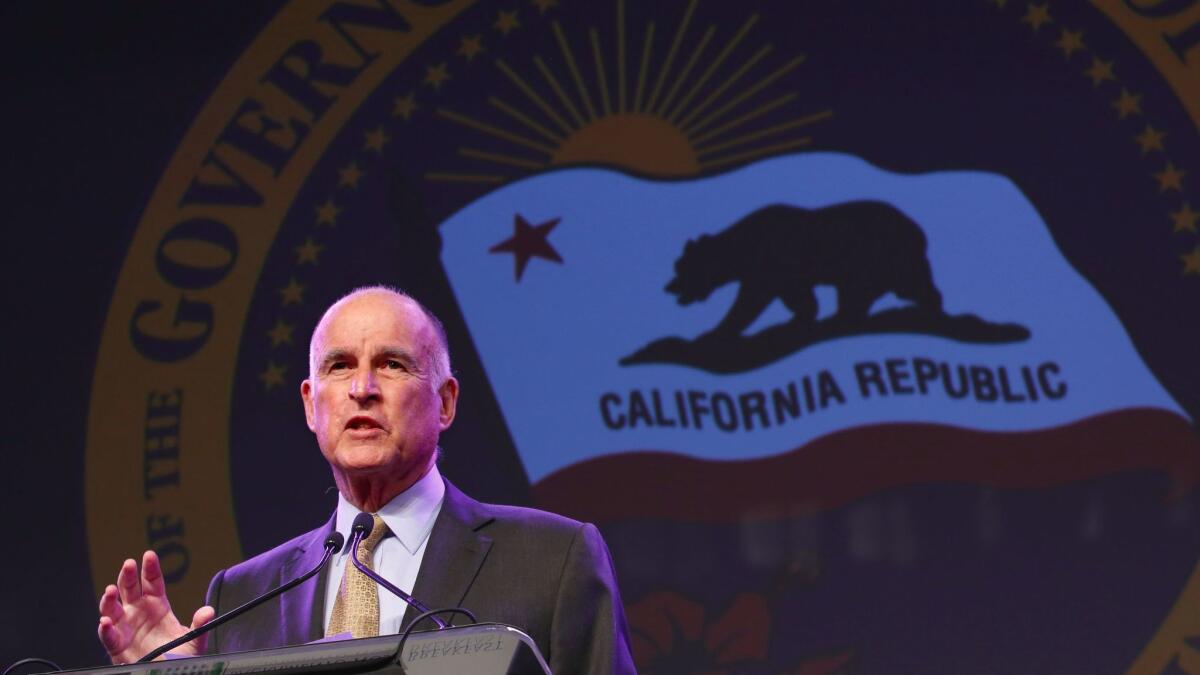Capitol Journal: While California spends liberally, the governor talks like a penny-pincher

Reporting from Sacramento — California’s status as a far-left state was emphatically reconfirmed by Gov. Jerry Brown’s revised budget last week — not so much by his proposal, but by his presentation.
Brown’s entertaining rhetoric itself made him sound, as usual, like a skinflint, a penny-pinching scold.
But the introductory document could have been written by Bernie Sanders, if not Depression-era Socialist Upton Sinclair, the losing 1934 Democratic candidate for governor who ran on the slogan “End Poverty in California.”
There are only a handful of states where a governor could get away with boasting on Page 1 of the budget that he was spending tax dollars for healthcare of immigrants living here illegally, even if they are children. Not that it isn’t a good idea — beats paying for expensive emergency room care when they get sick — but it would draw howls most places.
Same with bragging about gradually raising the minimum wage to $15 an hour, increasing payments to welfare moms when they have another baby or providing earned income tax credits for the working poor. This all costs tax dollars.
The very first paragraph introducing Brown’s $183.4-billion proposal says: “The past four budgets have significantly expanded government spending. The Legislature and the governor have focused the spending on counteracting the effects of poverty.”
And this on K-12 schools and community colleges: “Funding is expected to grow to $74.6 billion in [fiscal year] 2017-18 — an increase of $1.1 billion since January and $27.3 billion over six years (58%).”
OK, and how have the kids’ educations improved? The write-up doesn’t say.
Brown also sent an extra $6.5 million to Atty. Gen. Xavier Becerra so he can hire 31 more people to help fight President Trump. A reporter asked the governor what that was all about.
“You know, I just asked [Finance Director Michael] Cohen that this morning,” Brown replied. “He said, ‘Well, the attorney general is bringing a lot of lawsuits….’ We do have to defend our rights…. I think it’s reasonable.”
Clearly all this amounted to a written message to liberal legislators and anti-Trump activists that they shouldn’t fret. Brown already has checked off a bunch on their wish lists.
But for anyone watching the big picture nationally, reading it must have seemed surreal when matched against the dominant mood across America. This is a Republican country right now.
Trump carried 30 states to Hillary Clinton’s 20. He was a big winner in the electoral college, although Clinton narrowly won the popular vote, thanks in part to her 4.2-million-vote victory in California. Republicans control both houses of Congress and 32 state legislatures. Democrats dominate both houses in only 12 legislatures.
In governorships, Republicans outnumber Democrats 33 to 16.
California is a stark contrast. Democrats have supermajorities in both legislative houses and hold every statewide office. They outnumber Republicans in voter registration by roughly 45% to 26%.
There has been a huge leftward shift in the last two decades. Why? Lots of reasons, but the most important is growing ethnic and racial diversity. The GOP hard-line rhetoric on illegal immigration has helped Democrats immensely by offending many new voters of Latino and Asian ancestry.
Among Latino voters, Democrats outnumber Republicans 56% to 14%, according to Paul Mitchell, who heads Political Data Inc. Among Asians, it’s Democrats by 38% to 22%. Both groups have large numbers of independents who lean Democrat.
Whites are swing voters — as they’ve always been in California — with Democrats holding only a 39% to 33% edge in registration. But their percentage of the vote is gradually declining while people of color are gaining electoral clout.
Both legislative houses are led by Latinos who are always pushing to spend more money helping the poor.
There’s even a bill moving through the Legislature to provide free attorneys for immigrants here illegally who are facing federal deportation. Public defenders in state cases are one thing. But for the state to provide them for people accused of breaking federal law would be unprecedented.
So Brown again was playing the role of wise adult as he stood before reporters unveiling a revised budget proposal for next fiscal year.
Warning of the inevitable recession that will reduce tax flows and force budget cuts, the governor sounded almost like the sidewalk preacher proclaiming that “the end is near.”
“Sooner or later, we’re headed down,” he prophesied. “Make no doubt about it, cuts are coming over the next few years, and they’ll be big…. We would be imprudent just to start spending as though we have no risks.”
Besides a recession, risks include the threats of a huge cutback in federal healthcare funds and Trump’s retaliation against so-called sanctuary cities.
“Look, the world of Washington is changing by the hour,” Brown said. “So it’s very hard to predict what they will do…. But we’ve got to be wary and prudent.”
One reporter brought up an uncomfortable subject that contradicts Brown’s self-crafted image of fiscal prudence. That’s the $64-billion bullet train project that’s over-budget and behind schedule.
“What about it?” Brown said. “It’s speeding ahead. Have you been down there in Fresno and seen all the signs of construction? ... Look, these projects take a long time.”
The governor then ended the news conference.
Brown remains a fascinating political character. Aside from the bullet train, he does keep a thumb on spending in this lefty state.
Follow @LATimesSkelton on Twitter
ALSO
Trump presidency eases Gavin Newsom’s path in his second run for California governor
More to Read
Get the L.A. Times Politics newsletter
Deeply reported insights into legislation, politics and policy from Sacramento, Washington and beyond. In your inbox three times per week.
You may occasionally receive promotional content from the Los Angeles Times.











